Natalie M. Ball - Modoc/Klamath
Interview by Katie Zerzan
Winter 2011

Untitled, 2009
Katie Zerzan: How long have you been making art? Has it always been something you wanted to pursue?
Natalie M. Ball: I started painting when I was in undergraduate school at the University of Oregon. I was about 21 and had a young daughter when I entered college. I was majoring in Ethnic Studies and took a painting class as an elective my junior year. After that I was hooked and decided to double major in fine arts. For the next year and a half I took any fine arts class that I could. I always liked art or creating things since I was a kid, but I wasn’t traditionally trained in any medium. I never wanted to be or planned to be an artist as I am defined now. It just happened really.
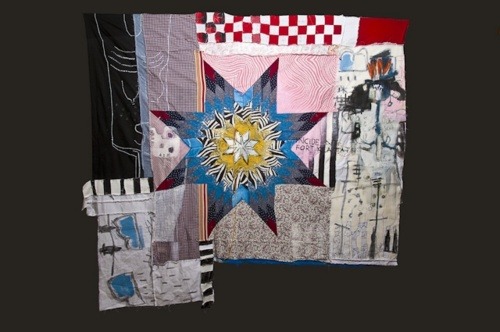
Incident At Fort Klamath, 2009
KZ: Do you consider yourself solely a Native American artist? Did the issues of blood quantum lead you to make work focused on Native American history? You have such an interesting background. Have you thought about including African history in your artwork?
NMB: Nah. My ancestry is the core of my work, my white and blackness is located and defined within a Native American identity, I guess you can say. But I try hard to not let myself stay stuck within that identity. I’m looking more at the idea of race as a social construct that can shift and change.
I think my experiences as an Indian lead me to focus on my Native American history and my life experiences. I can’t relate to the dominant images or histories or publicized realities of Native America. I find them really stuffy and static. Blood quantum is just an apparatus, one of many, which dictates our identity. I look specifically at my family and tribal history and its effect on us.
In a nutshell, my artwork is my attempt at meshing historical narratives with counter memory, a type of political fantasy, to warrant suspicion as to what is the truth in order to challenge inconsistent and problematic historical narratives belonging to Native America. I like to gut things.

Untitled, 2009
KZ: Your resume is impressive it seems like you started exhibiting as soon as you graduated. What path are you considering as far as a career in art?
NMB: I want to keep traveling and exhibiting. That’s what kept me so interested in my art. I was able to travel the world with my kid in tow, now I have added another kid to the picture and I plan to bring her along as well.
I want to introduce other media to my installations as well and see what I can do with them.
As a mama, as an Indigenous mama, I love what I do. I am proud of myself, that I am able to be a mama and give my kids experiences that can give them a better understanding of who they are. I’m trying to teach them to say “fuck you, this is who I am”… or something like it. It took me a while to be able to say that!
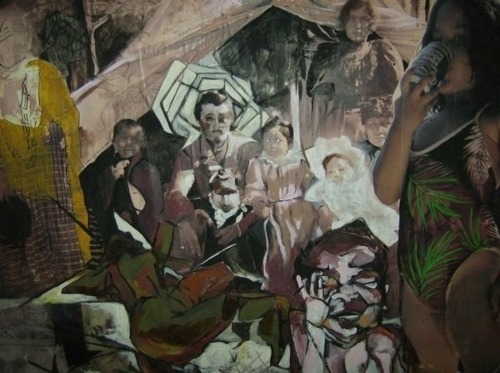
CAMP, 2007
KZ: Camp is really nice with the juxtaposition of new and old figures. Is this piece commenting on the supposed ‘evolvement’ of reservation life represented by the figures in the picture that were perhaps taken on a reservation?
NMB: That was one of my first pieces I ever made. I like it. It was before I knew what I wanted to talk about, before I had the lingo of the fine arts world, and the lingo that I needed to be able to talk about race, and before I really located myself. So it’s probably the coolest piece I will ever make! I am related to the woman on the far right. I found this photograph and wanted to insert myself somehow (that’s me in the purple bathing suit) and wanted to see what that looked like. It’s more of a reflection, really a starting point.
KZ: Are there specific or consistent misrepresentations of Native Americans that guide your work?
NMB: There are so many. I would say a couple that perpetuate Indians in a problematic way would be ethnographic photography, and other Indian artists.
KZ: On your website I enjoyed reading your artist statement about the Modoc Ghost Dance ceremonies. With your background in Ethnic Studies combined with Indigenous Visual Arts, do you feel like it is your job to educate the viewer by providing the history?
NMB: Hmmm. I don’t think it’s my job to educate the viewer anymore. Early on I did. I think it’s my job to be able to critically question and talk about the issues I locate and to be honest.
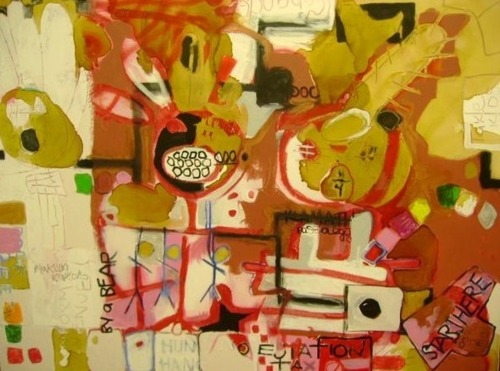
Daddy’s Outfit, 2008
KZ: I see some repeated similarities between you and Jean Michael Basquiat, especially in the quilt pieces, Savages, Daddy’s Outfit, Reload, and Three Women. I find it interesting that he was pulling from his background of being Haitian and you are pulling from your varied background. Have you had this comparison before, or can you see similarities?
NMB: I would have married that man if he had stuck around longer! Joking aside, I am a fan of his work for sure. I came to art without much exposure to the art world or other artists. I found out about him a couple years ago. People have compared our work and yes, I do see the similarities.
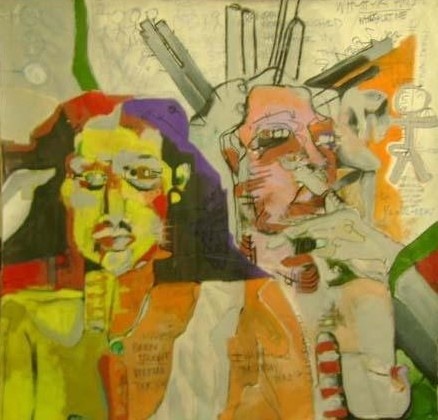
Reload, 2008
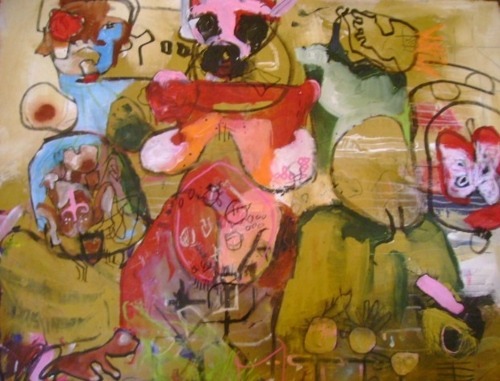
Three Women, 2008

The Savages, 2009
KZ: You work with a lot of different mediums photography, painting, and sewing. Which medium did you start out with first and how did you expand to other mediums? Is there a medium that you feel more comfortable with or enjoy more?
NMB: I started painting and evolved into installation (textiles, figurative sculpture (dolls), and audio) two years ago. The installation you are pulling from is my first one. I think it’s an expected progression for me.

Circa Indian, 2009 (Installation View)
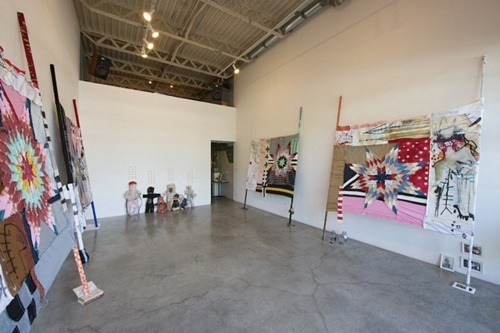
Circa Indian, 2009 (Installation View)
KZ: Did your degree in Ethnic Studies and Indigenous Visual Arts lead you to create your works about so-called “hidden histories”? What was it like going to school in New Zealand?
NMB: My time spent in New Zealand was needed. In a lot of ways, their Indigenous art scene is light years ahead of ours for many reasons. For three years I was able to have great dialog and to develop my ideas about my art. I needed to witness that and come home to start my own path separate from what other Indian artists are doing.
KZ: I noticed you show a lot in other countries. What has your experience been with audiences outside of the U.S. are they able to connect with your work?
NMB: Funny you ask. I am still unable to get many shows in the states. My work is more accepted, or wanted outside of the US. I could speculate on that, but that’s for another time. Outside of the US, even just up in Canada, they are open to connecting with my work. I think that’s the difference between the US & the rest of the world–being open.

The Savages, 2009 (detail)

The Savages, 2009 (detail)
KZ: What will you be working on next?
NMB: Right now I am working on three new bodies of work for a few shows this spring/summer, one of which is in the US! I am developing my dolls and the audio component of the installation. I am really excited about my dolls, I find them creepy and that’s their beauty.
I have been invited to the New York Smithsonian for an Indigenous conference as a panelist this spring. When I was invited I said to myself, “I’m not that ‘Indian!’.” Funny how my work and my discourse about Indian has lead me to the hub of Indian art. I am excited to talk about what Indian is to me in that space, because I think there is room for my kind of Indian.
Natalie M. Ball- Bio
Addressing issues of authenticity from questioning the role of blood quantum and tribal belonging to practices of ethnographic portraiture, I examine internal and external discourses that shape Indian identity through contemporary installation art. I believe historical discourses of Native Americans have constructed a limited and inconsistent visual archive that currently misrepresents our past experiences and misinforms current expectations.
As I excavate hidden histories, dominant narratives are artistically deconstructed through a theoretical framework of auto-ethnography. Painted quilts made of vintage and antique textiles, fabrics, and clothing are partnered with figurative sculpture then utilized to move “Indian” outside of governing discourses in order to rebuild a new visual genealogy in refusal to line-up with the many constructed existences of Native Americans. Each hand-made doll and painted star-quilt carries a new auto-ethnographic narrative, a new history, and a new manifestation for a healthier and a more critical way to understand Native America.
Because auto-ethnography refers to the self, my location as a descendent of African slaves, English soldiers, and a great great granddaughter of Kientpaush, also known as Captain Jack who led Modoc resistance during the Modoc War of 1872 informs my work. Within the thematic focus of my work and because of my descendancy, it is here where my artistic approach and interest lies.
With degree in Ethnic Studies and Indigenous Visual Arts, my work is always in discussion with racial narratives critical to understanding of both the self and the nation and necessarily, our shared experiences and histories. Because my work is not limited textually it goes beyond the language of memory to allow for witnessing that does not diminish the past or the present. The past is not the past.
My installations are visual invites for participation in new auto-ethnographic narratives by creating an inclusive space for negotiating identity, history, and experiences. This will give evidence of the plurality of my history and allow me to stand as a microcosm within history.
Resources:
http://NATALIEMBALL.COM/home.html
http://www.artcentral.ca/bulletins/118-natalie-m-ball-indian-circumvented
http://www.artcriesout.com/artist/nball.html
leoinstagram-blog liked this
boneforbone liked this
 lyra808-blog liked this
lyra808-blog liked this contemporarynativeartists posted this